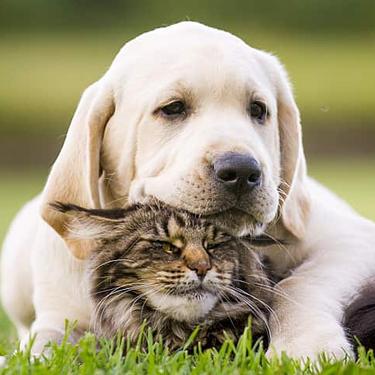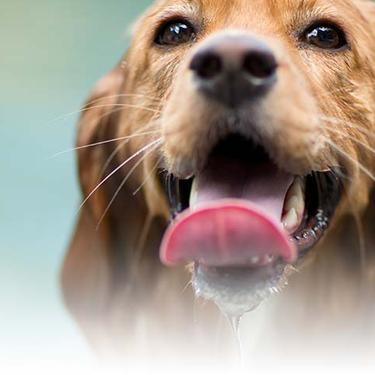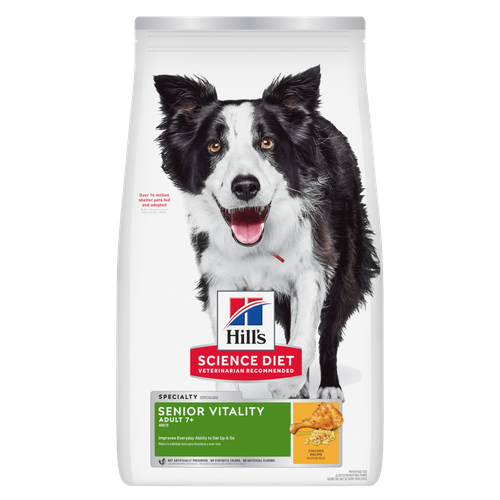
-
Find the right food for your petTake this quiz to see which food may be the best for your furry friend.Find the right food for your petTake this quiz to see which food may be the best for your furry friend.Featured products
 Puppy Large Breed Chicken & Brown Rice Recipe
Puppy Large Breed Chicken & Brown Rice RecipeVital nutrients to support 5 essential building blocks for lifelong health
Shop Now Puppy Lamb Meal & Brown Rice Recipe
Puppy Lamb Meal & Brown Rice RecipeVital nutrients to support 5 essential building blocks for lifelong health
Shop Now Hill's Science Diet Adult 7+ Senior Vitality Small & Mini Chicken & Rice Recipe Dog Food
Hill's Science Diet Adult 7+ Senior Vitality Small & Mini Chicken & Rice Recipe Dog FoodImproves everyday ability to get up & go
Shop NowFeatured products Adult Sensitive Stomach & Skin Cat Food
Adult Sensitive Stomach & Skin Cat FoodHighly digestible food that is gentle on the stomach. Nourishes skin & promotes lustrous fur.
Shop Now Adult Indoor Chicken Recipe Cat Food
Adult Indoor Chicken Recipe Cat FoodSupports energy level and beautiful fur in indoor cats
Shop Now Adult 7+ Chicken Recipe Cat Food
Adult 7+ Chicken Recipe Cat FoodSupports energy level and beautiful fur in mature cats
Shop Now -
Dog
- Dog Tips & Articles
-
Health Category
- Weight
- Food & Environmental Sensitivities
- Urinary
- Digestive
- Joint
- Kidney
-
Life Stage
- Puppy Nutrition
- Adult Nutrition
Cat- Cat Tips & Articles
-
Health Category
- Weight
- Skin & Food Sensitivities
- Urinary
- Digestive
- Kidney
-
Life Stage
- Adult Nutrition
Featured articles The Incredible Science Behind Your Pet's Microbiome
The Incredible Science Behind Your Pet's MicrobiomeLearn what a pet's microbiome is, how it contributes to your pet's gut & overall health, and why nutrition is important in maintaining healthy microbiomes.
Read More Pet Food Storage Tips
Pet Food Storage TipsDiscover how and where to store your dry, as well as canned, dog and cat food. Learn how to find the "best before" dates on all Hill's pet food packaging.
Read More Water
WaterDiscover why water is the most important nutrient for your dog or cat to live a healthy life. Find out how much water your pet should consume each day.
Read More -


Overheating in dogs is not something to take lightly. As the weather heats up, it's important to remain aware of how the heat affects your pup. Heat exhaustion in dogs can lead to serious and potentially fatal conditions such as heat stroke and cardiac arrest. To help keep your dog safe and cool during the summer, here is the lowdown on signs that he's overheating and how to prevent it: hint, a little water does wonders for keeping your pup cool.
Heat Exhaustion and Heat Stroke
Unlike people, dogs don't sweat out excess body heat. While your dog does have a few sweat glands located in his paws, these do little to help regulate his body temperature. Instead, he does this through rapid, open-mouthed breathing, called panting. But sometimes panting isn't enough to keep him from getting overheated.
Heat exhaustion in dogs can occur when the body temperature becomes elevated above the normal temperature. This varies slightly, according to PetMD.com, but it's generally agreed that temperatures of 103 degrees Fahrenheit and higher are above normal. If the temperature continues to rise and reaches 106 or higher, your pup is in the danger zone for heat stroke, during which the organs begin to shut down and his heart could stop altogether.
Warning Signs
Fortunately, it's not difficult to spot signs of overheating in dogs. Excessive panting is the first symptom. A dangerously overheated dog, according to the American Kennel Club Canine Health Foundation, may collapse or experience convulsions, exhibit vomiting or diarrhea, and may also have gums or a tongue that turn blue or bright red. You may want to identify the problem before it gets that severe, though to intervene and prevent serious overheating. Early signs are more subtle - it may be as simple as your dog seems less responsive to commands than usual. When you call his name, instead of turning to look at you, he may wander away. If there is any question at all, get your dog out of the heat. The Humane Society of the United States adds that signs of potential heat stroke include glazed eyes, excessive drooling, a rapid heart rate, dizziness or lack of coordination, fever, lethargy, and loss of consciousness.
Risk Factors

While all dogs are at risk for overheating if the conditions are right, some breeds are more prone to it than others. This includes dogs with thick coats or long hair, very young or very old dogs, and brachycephalic breeds—those with short noses and flat faces, such as shih tzus, pugs, boxers, and bulldogs. Overweight dogs and those that suffer from medical conditions that cause difficulty breathing or heart problems are especially susceptible.
Extremely active dogs and working or hunting breeds (such as shepherds, retrievers, and spaniels) are also at a higher risk, especially during warm months. You should be careful to not push these dogs too hard, so make sure they get plenty of breaks to rest in the shade and that they are well-hydrated at all times.
Environmental factors can also place a dog at risk. Be aware not just of high temperatures, but also of high humidity, which can increase the chance of heat exhaustion in dogs. All dogs are at increased risk of overheating if they're not given adequate shade or another cooler place to relax indoors. And dogs left in a hot car are in serious danger of heat exhaustion and heat stroke.


Tasty Tips
What to Do if Your Dog Is Overheated
At the first sign of overheating, immediately take action to cool down your dog. Vetstreet recommends the following steps to treat heat exhaustion in dogs:
- Immediately move your dog to a cooler area, either indoors where there is air conditioning or in the shade under a fan.
- Use a rectal thermometer to check his temperature. Heat exhaustion typically occurs when a dog's temperature falls between 103 and 106 degrees. A temperature above 106 places him at risk for heat stroke. If he's in the danger zone, call your veterinarian.
- If you're near a body of fresh water, such as a lake or a baby pool, let your dog take a dip to cool down. Otherwise, you can use cool, wet cloths or towels to help him out. Place your cool wet cloths on his neck, armpits, and between his hind legs, and you can also gently wet his ears and paw pads with cool water.
- If he's conscious and willing to drink, give him cool, fresh water. Don't force it, however, as it may end up in his lungs. If he can't or won't drink, or can't keep water down, wet his tongue with water instead. Don't feed him ice cubes, which could cause his temperature to drop too quickly, leading to shock.
- Get him to the vet. If you haven't already done so, call ahead so they can be ready to take immediate action as soon as you arrive.
Avoiding Heat Exhaustion in Dogs
Of course, the best cure is prevention. You can help keep your pooch from overheating with some basic safety practices. These include limiting exercise or outdoor activity on excessively hot or humid days, providing plenty of shade and water when your dog is outdoors, and never, under any circumstances, leaving your pet in a parked car—not even in the shade with the windows rolled down. On mild days with temperatures in the 70s, the inside of a parked car can reach 120 degrees in minutes, making this an extremely dangerous environment to leave your dog, even for a short time.

If your pooch has energy to burn and needs some form of exercise in order to stay calm, take him swimming or let him run and play in the sprinkler before heading back indoors. You can also use a cooling body wrap or vest to help keep him cool without getting him wet. And if your dog has long hair or a thick coat, consider getting him a short haircut to get through the hot months—just be sure to leave enough fur to protect his skin from the sun.
Additionally, if you take your dog on long walks it might be better to take him during the cooler hours of the day such as early in the morning or later in the evening (keep in mind hot sidewalks and pavement can burn his footpads). Be sure to keep water with you and let him take a break every once in a while. If you run with your dog make sure to not overdo it. Just as hotter temperatures make it harder for you to stay hydrated on a nice run, it's even more true for your pup.
If you'll be hunting or hiking with your dog, or if he has a job to do such as herding sheep or cattle, be sure to give your dog several breaks in the shade and make sure he has plenty of fresh water. Consider wetting him down or using a cooling vest while he's active, and keep a close watch on him for the first signs of overheating. Remember that working dogs tend to become so focused on their tasks that they don't realize when they need to rest and cool down. It's up to you to monitor your dog and make sure he gets the breaks he needs to stay healthy.
Finally, don't forget to put a plan in place for keeping your dog cool if the power goes out or the air conditioner stops working. As uncomfortable as you might be under such conditions, it's even worse for your dog, whose body temperature is already much higher than yours. If you plan to retreat to someplace cooler, be sure he'll also be welcome. Otherwise, consider leaving him at a kennel until it's safe for him to return home to cooler conditions.
Armed with the knowledge of how to recognize overheating, how to respond and how to avoid it in the first place, you can look forward to a safe, fun and happy summer with your four-legged friend.


Jean Marie Bauhaus is a pet parent, pet blogger, and novelist from Tulsa, Oklahoma, where she usually writes under the supervision of a lapful of fur babies.
Related products

Vital nutrients to support 5 essential building blocks for lifelong health

Vital nutrients to support 5 essential building blocks for lifelong health

Improves Everyday Ability to Get Up & Go

Improves everyday ability to get up & go
Related articles

Learn basic steps & precautions for treating a cut on your dog, including what you can put on the cut, and when you should take them to the vet.

Understand the role that Omega-6 and Omega-3 fatty acids play in your dog's overall health, and how you can ensure they are getting enough.

Discover fun and engaging games and other ways to help your dog exercise, keeping him happy and healthy.

Learn how to stop your dog from begging at the dinner table, and understand how it can help contribute to his health.

Put your dog on a diet without them knowing
Our low calorie formula helps you control your dog's weight. It's packed with high-quality protein for building lean muscles, and made with purposeful ingredients for a flavorful, nutritious meal. Clinically proven antioxidants, Vitamin C+E, help promote a healthy immune system.
Put your dog on a diet without them knowing
Our low calorie formula helps you control your dog's weight. It's packed with high-quality protein for building lean muscles, and made with purposeful ingredients for a flavorful, nutritious meal. Clinically proven antioxidants, Vitamin C+E, help promote a healthy immune system.

